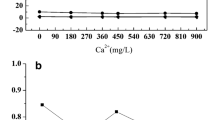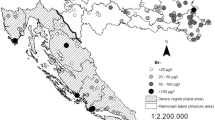Abstract
Brominated organic and inorganic by-products are generated during ozonation of groundwater containing high bromide concentrations. This study measured concentrations of bromate, bromoform, bromoacetic acids, bromoacetonitriles, bromoacetone, 2,4-dibromophenol and aldehyde generated by ozonation. The potential mutagenicity of ozonated waters was assessed using the Ames and Microtox tests. Test results for the 18 ozonated groundwater samples demonstrate that bromate formation is associated with high pH, bromide and alkalinity content, low levels of dissolved organic carbon (DOC) and ammonia, and low alkalinity. Brominated organic by-products were correlated with high bromide ion and natural organic matter content, and low ammonia concentrations. The Ames test results demonstrate that all extracts from ozonated water have mutagenic activity; however, the 18 raw groundwater samples had no mutagenicity. The Microtox test results also show that the ozonated water samples were highly toxic. Generally, both bromide and DOC content promoted the formation of ozonation by-products and mutagenicity. Controlling of bromide and DOC concentrations is an effective method of reducing potential by-product formation and eliminating mutagenicity problems associated with groundwater ozonation.
Similar content being viewed by others
References
Amy, G. (1994). Survey on bromide in drinking water and impacts on DBP formation. American Water Works Research Foundation Report. Denver: AWWA Research Foundation and American Water Works Association.
APHA, AWWA, & WEF (2005). Standard methods for the examination of water and wastewater, 21st ed. Washington, DC.
Dore, M. (1988). Interactions between ozone, halogens, and organic compounds. Ozone Science and Engineering, 10(2), 1531–1562.
Haag, W. R., & Hoigne, J. (1983). Ozonation of bromide containing waters: Kinetics of formation of hypobromous acid and bromate. Environmental Science & Technology, 17(6), 2617–2624.
Krasner, S. W. (1993). Formation and control of bromate during ozonation of waters containing bromide. Journal of the American Water Works Association, 85(1), 73–80.
LaLonde, R. T., Bu, L., Henwood, A., Fiumano, J., & Zhang, L. (1997). Bromine-, chlorine- and mixed halogen-substituted 4-methyl-2(5H)-furanones: Synthesis and mutagenic effects of halogen and hydroxyl group replacements. Chemical Research in Toxicology, 10(12), 1427–1436. doi:10.1021/tx9701283.
Lawrence, J., Tosine, H., Onusaka, F. I., & Comba, M. E. (1980). The ozonation of natural waters: Product identification. Ozone Science and Engineering, 2(1), 55–66. doi:10.1080/01919518008550868.
Maron, D. M., & Ames, B. N. (1983). Revised methods for the Salmonella mutagenicity test. Mutation Research, 113(3–4), 173–215.
Monarca, S., Zani, C., Richardson, S. D., Thruston, A. D., Jr, Moretti, M., Feretti, D., et al. (2004). A new approach to evaluating the toxicity and genotoxicity of disinfected drinking water. Water Research, 38(17), 3809–3819. doi:10.1016/j.watres.2004.07.003.
Nobukawa, T., & Sanukida, S. (2001). Effect of bromide ions on genotoxicity of halogenated by-products from chlorination of humic acid in water. Water Research, 35(18), 4293–4298. doi:10.1016/S0043-1354(01)00157-9.
Richardson, S. D., Thruston, A. D., Jr, Caughran, T. V., Chen, P. H., Collette, T. W., & Floyd, T. L. (1999). Identification of new ozone disinfection by-products in drinking water. Environmental Science & Technology, 33(19), 3368–3377. doi:10.1021/es981218c.
Richardson, S. D., Thruston, A. D., Jr, Caughran, T. V., Chen, P. H., Collette, T. W., Schenck, K. M., et al. (2000). Identification of new drinking water disinfection by-products from ozone, chlorine dioxide, chloramines, and chlorine. Water, Air, and Soil Pollution, 123, 95–102. doi:10.1023/A:1005265509813.
Schechter, D. S., & Singer, P. C. (1993). Comparative formation of ozonation by-products in real and model waters. Proceeding American Water Works Association Annual Conference. San Antonio, TX.
Siddiqui, M. S., & Amy, G. L. (1993). Factor affecting DBP formation during ozone-bromide reactions. Journal of the American Water Works Association, 85(1), 63–72.
Siddiqui, M. S., Amy, G. L., & Rice, R. Q. (1995). Bromate ion formation: A critical review. Journal of the American Water Works Association, 87(10), 58–70.
Trehy, M., & Bieber, T. (1986). Chlorination by-products of amino acids in natural water. Environmental Science & Technology, 20(7), 1117–1124. doi:10.1021/es00153a006.
United States Environmental Protection Agency (1997). SW-846 Version 2.0. Test methods for evaluating solid waste physical/chemical methods including final update III. PB97-501928. Washington, DC: USEPA.
United States Environmental Protection Agency (2001). National primary drinking water regulations: Stage 2 disinfectants and disinfection byproducts rule. Washington, DC: USEPA.
von Gunten, U. (2003a). Ozonation of drinking water. Part I. Oxidation kinetics and product formation. Water Research, 37(7), 1443–1467. doi:10.1016/S0043-1354(02)00457-8.
von Gunten, U. (2003b). Ozonation of drinking water. Part II. Disinfection and by-product formation in presence of bromide, iodide and chlorine. Water Research, 37(7), 1469–1487. doi:10.1016/S0043-1354(02)00458-X.
von Gunten, U., & Hoigné, J. (1994). Bromate formation during ozonation of bromide-containing waters: Interaction of ozone and hydroxyl radical reactions. Environmental Science & Technology, 28(8), 1234–1242. doi:10.1021/es00056a009.
World Health Organization (2005). Chemical hazards in drinking-water, bromate in drinking water: Background document for development of WHO guidelines for drinking-water quality. Geneva, Switzerland: World Health Organization.
Author information
Authors and Affiliations
Corresponding author
Rights and permissions
About this article
Cite this article
Huang, WJ., Chang, CY. & Shih, FH. Disinfection by-product formation and mutagenic assay caused by preozonation of groundwater containing bromide. Environ Monit Assess 158, 181–196 (2009). https://doi.org/10.1007/s10661-008-0572-3
Received:
Accepted:
Published:
Issue Date:
DOI: https://doi.org/10.1007/s10661-008-0572-3




